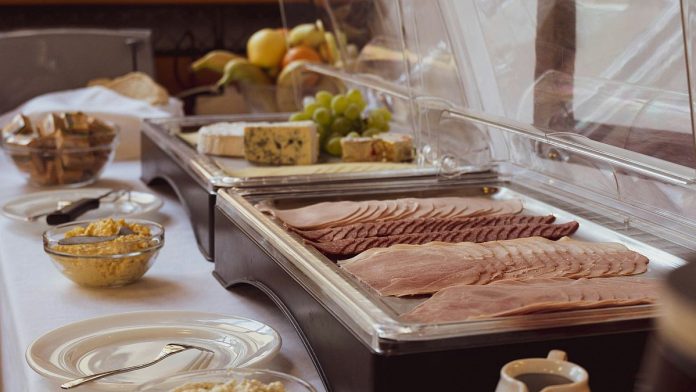Seeing masses of food being thrown away at the top of a buffet breakfast led me to analyze hotel food waste.
On a recent holiday to Tenerife within the Canary Islands, I stayed on the Meliá Sol Arona hotel. It was a full buffet breakfast, with every option and cuisine you’ll be able to consider.
At the top of the service, while I used to be still seated, staff began clearing away the leftover food from the buffet stations. To my shock, they wheeled in giant outdoor bins and started shovelling the food of the platters directly into the bins. Many of the food was untouched and presumably fresh.
Strict food safety regulations may be difficult to navigate little doubt. But like every business, hotels have an obligation to make sure they’re making every effort possible to cut back food waste.
The UN Environment Programme’s Food Waste Index Report 2024 found that 1.05 billion tonnes of food went to waste in 2022.
Around 19 per cent of food available to consumers was lost overall at retail, food service and household levels.
So what are hotels doing to minimise food waste and does the breakfast buffet have a future?
How can hotel buffets minimise food waste?
“Food safety laws imposes strict guidelines on hotels,” Lourdes Ripoll de Oleza, Sustainability VP for Meliá Hotels International, says in response to my experience in Tenerife. Meliá Hotels has over 200 properties in Europe and is the seventeenth biggest hotel chain worldwide.
“Any food product exposed for consumption and never consumed by the shopper is discarded to mitigate any potential health risks.”
Which means within the case of buffet-style offerings, all of the food that sits out on counters should be discarded even when it has not been touched.
In accordance with the federal government of Ireland’s National Waste Prevention Program, buffet breakfasts typically lead to over double the food waste per customer (300 grams) in comparison with those served from a menu (130g).
To make their breakfasts more sustainable, some hotels have scrapped the buffet formula altogether. Some just never brought them back after COVID put a stop to shared food stations.
But Michelin-starred chef Massimo Bottura says there are benefits of the buffet for guests and there are methods it might probably be made more sustainable.
“Buffets, not only breakfast buffets, began as a way of offering guests a taste of local tradition,” he explains.
“But over time, what was considered a chance to enjoy small samples of recipes that represent local terroir became one in every of overconsumption, selection and inevitably waste.”
At his property Casa Maria Luigia in Modena, Italy, steps have been taken including offering guests smaller plates, reducing portion sizes of pastries and bread servings, and giving guests tricks to help them make appropriate portion selections.
Bottura also recommends hotels have live cooking stations where dishes are prepared on the spot. This can be a fun guest experience but additionally means reducing the excess of pre-prepared food.
With plated meals, reducing food waste is somewhat easier.
“Our plated meal offerings portion sizes are rigorously considered by our Food and Beverage management to minimise excess,” says Ripoll de Oleza.
“In instances where there are leftovers, our company endeavours to donate such surplus food to reputable social entities with whom we’ve got established partnerships locally.
“Alternatively, we also attempt to sell it through platforms similar to TOO GOOD TO GO, thereby minimising waste while contributing to socially responsible initiatives,” she adds.
How can hotel guests be encouraged to cut back food waste?
Some responsibility also lies with hotel guests and their very own self-regulation.
“From the kitchen to the dining room, informative messages may be displayed organically in regards to the effects of wasting food and the way guests may be a part of the change while dining out or once they return to their home kitchens,” Bottura suggests.
“By highlighting a menu with environmentally friendly and plant-based forward selections, the team can encourage guests to make a right away difference, sharing the benefit during which leftovers may be transformed into something delicious.”
How can hotel kitchens turn out to be more sustainable?
For Bottura, being more sustainable and reducing food waste is a chance to get more creative and experimental within the kitchen.
“A sustainable kitchen plans well by understanding the guest consumption habits, measuring and adjusting recipes with portion control to cut back food waste from purchasing to the plate,” he says.
“In my kitchen, food surplus and scraps are a chance for our chefs to make use of their creativity and showcase what is feasible once we reimagine.”
He gives the instance of bread, which, when hardened the second day may be used to make a Tuscan tomato soup or bread pudding. After two days, it continues to be useful for breadcrumbs, pasta and cakes.
“We frequently use our trimmings – vegetables and fruits – in lots of preparations to make the flavour much more intense,” he adds.
Potato skins, onion peel and carrot peel are toasted and used to make broth while fruit skins, like peach, watermelon and cucumber may be used so as to add color and flavour to dishes and drinks. The peel of oranges pressed for orange juice is used to make marmalade.
“Educating and training team members on the consequences of food waste and implementing effective food-saving actions is crucial to achieving the numerous reductions set in the worldwide UN sustainable agenda,” Bottura says.
“By fostering a culture of innovation and responsibility, we are able to turn what would have been waste into culinary treasures.”
Can AI help hotels and kitchens reduce food waste?
Some hotels are experimenting with artificial intelligence (AI) to tackle food waste problems.
The Accor hotels group says it has partnered with technology company Orbisk to introduce AI into its kitchens.
The group says trials in 10 European hotels resulted in a 22 per cent reduction in food waste in six months.
Orbisk’s system employs AI image recognition technology to trace ingredients which are thrown away, in what quantities and when.
This data then allows the kitchen teams to discover where the largest losses are and implement dedicated solutions.
Unlock the world’s wonders with unforgettable journeys tailored just for you! Whether you crave sun-kissed beaches, thrilling adventures, or rich cultural escapes, your dream destination awaits. Enjoy seamless travel with expert tips, exclusive deals, and handpicked experiences that Turn Every Trip into a lifetime memory.










